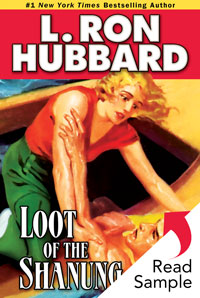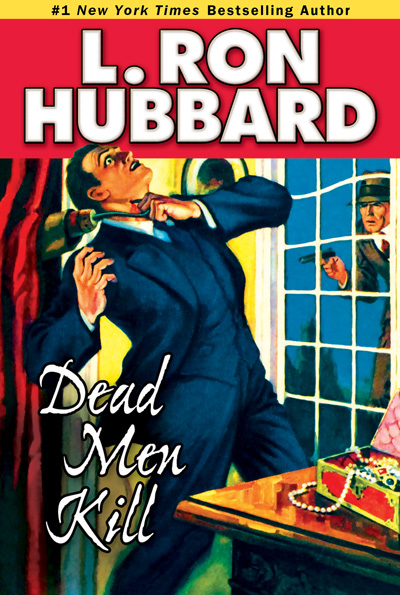Loot of the Shanung Glossary
Stories from the Golden Age reflect the words and expressions used in the 1930s and 1940s, adding unique flavor and authenticity to the tales. While a character’s speech may often reflect regional origins, it also can convey attitudes common in the day. So that readers can better grasp such cultural and historical terms, uncommon words or expressions of the era, the following glossary has been provided.
bearder: one who boldly confronts or challenges (someone formidable).
Bias Bay: body of water off the coast of China, fifty miles northeast of Hong Kong, and notorious as a base of operations for Chinese pirates.
bitt: a vertical post, usually one of a pair, set on the deck of a ship and used for securing cables, lines for towing, etc.
blackguard: a man who behaves in a dishonorable or contemptible way.
bow chasers: a pair of long guns mounted forward in the bow of a sailing warship to fire directly ahead; used when chasing an enemy to shoot away her sails and rigging.
bow eyes: eyes painted on either side of the bow of a ship. The term comes from the ancient custom of painting eyes on the bow so that the ship could see where she was going.
bridge wings: narrow walkways extending outward from both sides of a pilothouse to the full width of a ship.
broadside: all the guns that can be fired from one side of a warship or their simultaneous fire in naval warfare.
Bund: the word bund means an embankment and “the Bund” refers to a particular stretch of embanked riverfront along the Huangpu River in Shanghai that is lined with dozens of historical buildings. The Bund lies north of the old walled city of Shanghai. This was initially a British settlement; later the British and American settlements were combined into the International Settlement. A building boom at the end of the nineteenth century and beginning of the twentieth century led to the Bund becoming a major financial hub of East Asia.
Canton: city and port in the southern part of China, northwest of Hong Kong.
Chinwangtao: port city of northwest China on the Bo Hai Sea, an inlet of the Yellow Sea, 186 miles (300 km) east of Beijing. It was formerly a treaty port where foreign trade was allowed.
cleats: pieces of metal or wood having projecting arms or ends on which a rope can be wound or secured.
cockpit: a cabin on the lower deck of a man-o’-war where the wounded in battle were tended.
Cossack jacket: cherkeska; a military coatlike garment with silver cartridges lined across the chest. The cartridges are a reminder of the times when the Cossacks were armed with muzzle-loading guns. At that time, each cartridge contained enough gunpowder for one shot. When breech-loading weapons came into use, the holders were retained as part of the costume.
crate: an airplane.
crosstrees: a pair of horizontal rods attached to a sailing ship’s mast to spread the rigging, especially at the head of a topmast.
davits: any of various cranelike devices, used singly or in pairs, for supporting, raising and lowering boats, anchors and cargo over a hatchway or side of a ship.
Davy Jones’ locker: the ocean’s bottom, especially when regarded as the grave of all who perish at sea.
dead to rights: in the very act of committing a crime, offense or mistake; red-handed.
dodger: a canvas or wood screen to provide protection from ocean spray on a ship.
dyed-in-the-wool: thoroughgoing; out-and-out.
fills: copy used primarily to fill extra space in a column or page of a newspaper or periodical, especially a brief item of fact as from a reference book.
five-spot: a five-dollar bill.
fo’c’s’le: forecastle; the upper deck of a sailing ship, forward of the foremast.
forecastle head: the extreme fore part of the upper deck of a sailing ship, forward of the foremast.
foredeck: the part of a ship’s deck between the bridge and the forecastle (the upper deck of a sailing ship, forward of the foremast).
founder: to sink below the surface of the water.
fulminate: fulminate of mercury; a gray crystalline powder that when dry explodes under percussion or heat and is used in detonators and as a high explosive.
gaff: a pole rising aft from a mast to support the top of a sail.
galleon: a large three-masted sailing ship, usually with two or more decks; used mainly by the Spanish from the fifteenth to eighteenth centuries for war and commerce.
gangway: a narrow, movable platform or ramp forming a bridge by which to board or leave a ship.
gats: pistols.
G-men: government men; agents of the Federal Bureau of Investigation.
gun captain: a petty officer in command of a gun crew on a ship.
gunwale: the upper edge of the side of a boat. Originally a gunwale was a platform where guns were mounted, and was designed to accommodate the additional stresses imposed by the artillery being used.
hawsers: cables or ropes used in mooring or towing ships.
heave to: to bring a ship to a stop.
horse pistol: a single-shot .58-caliber handgun created in 1805, resembling a short-barreled rifle. The gun was designed to be carried in a holster on the side of a horse, and was known as a hard-hitting and powerful weapon.
Huangpu: a long river in China flowing through Shanghai. It is a major navigational route, lined with wharves, warehouses and industrial plants, and provides access to Shanghai for oceangoing vessels.
hull down: sufficiently far away, or below the horizon, that the hull is invisible.
junk: a seagoing ship with a traditional Chinese design and used primarily in Chinese waters. Junks have square sails spread by battens (long flat wooden strips for strengthening a sail), a high stern and usually a flat bottom.
key: a hand-operated device used to transmit Morse code messages.
Kowloon: a city of southeastern China on Kowloon Peninsula opposite Hong Kong Island.
lazarette: a small storeroom within the hull of a ship, especially one at the extreme stern.
Manchukuo: a former state of eastern Asia in Manchuria and eastern Inner Mongolia. In 1932 it was established as a puppet state (a country that is nominally independent, but in reality is under the control of another power) after the Japanese invaded Manchuria in 1931. It was returned to the Chinese government in 1945.
Mex: Mexican peso; in 1732 it was introduced as a trade coin with China and was so popular that China became one of its principal consumers. Mexico minted and exported pesos to China until 1949. It was issued as both coins and paper money.
midshipman: a student naval officer educated principally at sea.
military brushes: a pair of matched hairbrushes having no handles, especially for men.
morning coat: a man’s single-breasted coat. The front parts usually meet at one button in the middle, and gently curve away into a pair of tails behind. The coat can be gray or black and is usually worn with striped trousers. The name derives from the fact that a common form of morning exercise for gentlemen in the nineteenth century was horseback riding, and because of this it was regarded as a more casual way of dress.
newshawk: a newspaper reporter, especially one who is energetic and aggressive.
painter: a rope, usually at the bow, for fastening a boat to a ship, stake, etc.
powder monkeys: boys employed on warships to carry gunpowder from the magazine to the guns.
press ganging: forcing (a person) into military or naval service.
quarter: mercy or indulgence, especially as shown in sparing a life and accepting the surrender of a vanquished enemy.
ratline: a small rope fastened horizontally between the shrouds in the rigging of a sailing ship to form a rung of a ladder for the crew going aloft.
sampan: any of various small boats of the Far East, as one propelled by a single oar over the stern and provided with a roofing of mats.
Scheherazade: the female narrator of The Arabian Nights, who during one thousand and one adventurous nights saved her life by entertaining her husband, the king, with stories.
sculling oar: a single oar that is moved from side to side, at the stern of a boat, to propel it forward.
scuppers: openings in the side of a ship at deck level that allow water to run off.
Seven Great Sea Oaths: an abundance of profanities or swearwords. The Seven Great Seas is in reference to the many seas of the world.
Seventh Hell: according to the Moslems, hell is divided into seven stories or cellars, the lowest being the seventh.
Shanghai: city of eastern China at the mouth of the Yangtze River, and the largest city in the country. Shanghai was opened to foreign trade by treaty in 1842 and quickly prospered. France, Great Britain and the United States all held large concessions (rights to use land granted by a government) in the city until the early twentieth century.
Shantung: a peninsula in east China extending into the Yellow Sea.
spars: strong poles, especially those used as masts to support the sails on ships.
spat: a piece of cloth or leather covering the ankle and part of the shoe, and fastened on the side of the shoe. Spats are worn by men.
SS: steamship.
steerageway: the minimum rate of motion sufficient to make a ship or boat respond to movements of the rudder.
sweeps: long, heavy oars.
.38 Colt: a .38-caliber automatic handgun manufactured by the Colt Firearms Company, founded in 1847 by Samuel Colt (1814–1862) who revolutionized the firearms industry with his inventions.
thole: a holder attached to the gunwale of a boat that holds the oar in place, and acts as a fulcrum for rowing.
tiffin: a meal at midday; a luncheon.
transom: transom seat; a kind of bench seat, usually with a locker or drawers underneath.
waist: the central part of a ship.
Who’s Who: a reference book or reference serial providing brief biographical information about well-known people who are still living.
Yangtze: the longest river in Asia and the third longest in the world, after the Nile in Africa and the Amazon in South America.
Yellow Sea: an arm of the Pacific Ocean between the Chinese mainland and the Korean Peninsula. It connects with the East China Sea to the south.












